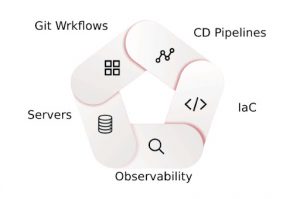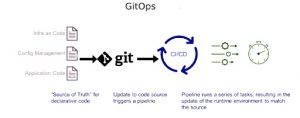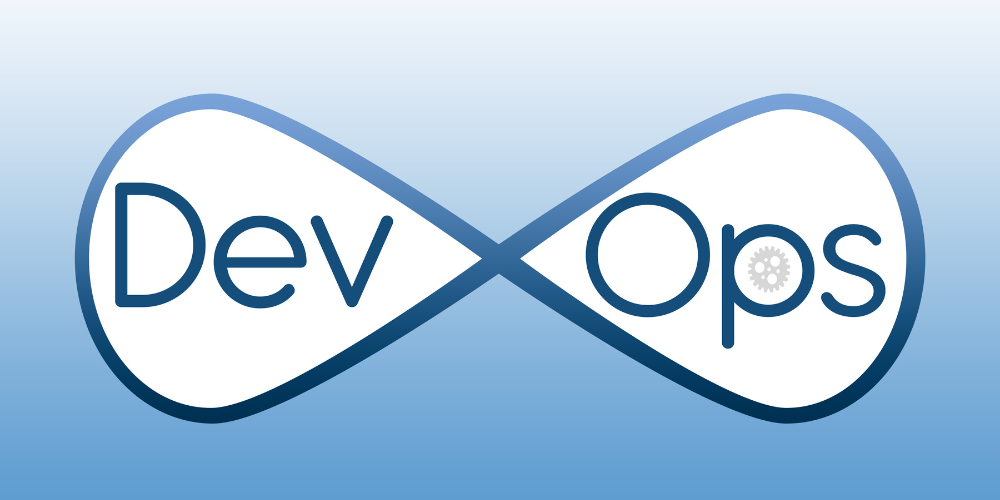Introduction
GitOps is a relatively new concept in software development and infrastructure management. It’s a way of managing and deploying applications and infrastructure as code (IAC) using Git as the single source of truth. With GitOps, the entire deployment pipeline, from development to production, is automated and managed through Git. GitOps can deliver and maintain Kubernetes infrastructure. Infrastructure and platform-specific business applications are other descriptions. This approach provides several benefits over traditional deployment methods, including increased speed, reliability, and security. This blog will describe GitOps’ concepts and practices, outlining why and how automated processes build secure, high-quality, microservice-based applications fast and effectively.
GitOps
The benefits and aims of GitOps are pretty obvious. GitOps ensures a smooth, consistent, and trustworthy deployment of applications across different namespaces or clusters. Groups may use Git to safely save the configurations for their servers and applications. If calamity strikes, you can confidently and quickly relaunch the app. GitOps will also facilitate app testing and development for businesses.
Two different groups inside an organization often handle infrastructure and application development. The Kubernetes platform is defined and delivered based on the infrastructure configuration, which includes computing nodes, operators, role-based access control, governance policies, and other attributes that allow applications to run. Kubernetes resources set up the container images for a particular environment, and application source code components compile to an executable within a container image.
A few simple guidelines govern GitOps:
Git is the single source of truth
All git commits will be handled via a workflow or automation.
Any changes you make to the environment by hand are rolled back instantly.
GitOps draws on even more of the DevOps philosophy and toolset. There is no definitive answer to the question “What is GitOps?” but it does entail valuable automation and a method of working that makes it possible to record, disseminate, and roll back organizational changes.
GitOps defines a Git repository as the authoritative source for an application’s settings. Teams may easily make changes to the application’s configuration in the corresponding Git repository and then wait for the automated procedure to do the rest. This process may be augmented with external ticketing systems and Git pull requests to ensure that only authorized changes are sent to production environments.
The Four Principles of GitOps
GitOps is a way of managing and operating infrastructure as code, which follows certain best practices. These best practices are defined by four principles, as defined by Alexis Richardson:
Declarative Description of the Entire System: The system, including applications, infrastructure, and containers, can be described and managed using declarative commands stored in a central Git repository.
Versioned Desired System State in Git: All changes and declarations in the system are stored in a single source of truth, such as a Git repository, which makes rollbacks, upgrades, and deployments more accessible and more secure.
Automated Application of Approved Changes: With the system definition stored in a closed and change-controlled environment, changes can be automatically applied to the system through CI/CD, reducing the complexity and risk associated with manual intervention.
Software Agents for Correctness and Convergence: By monitoring changes in the repository, software agents can automatically reconcile the cluster to match the desired state, providing automated fixes, QA processes, protection against human error, and self-healing capabilities.
Components of GitOps
GitOps is a practice that incorporates best practices from existing methodologies to streamline the management of applications and infrastructure. Here are the critical components of GitOps:

Git Workflows: GitOps leverages Git repositories to update applications and infrastructure. Any changes made to the application or environment are reflected in the Git repository, providing a comprehensive history and the ability to revert to a previous version at any time.
Continuous Deployment Pipelines: In GitOps, there is a clear distinction between Continuous Integration (CI) and Continuous Deployment (CD). Instead of triggering the CI/CD process through a code commit, GitOps triggers it through a commit to the configuration repository. The CI pipelines remain unchanged, and their output is stored in a binary repository as an artifact or container. Once the artifact is created, GitOps deploys it to the target cluster.
Infrastructure as Code (IaC): GitOps uses a Git repository as the source of truth for environments. IaC refers to storing all infrastructure configurations in a version control system in code. IaC systems use declarative formats, which only specify the desired outcome and not the methodology.
Tracking and Observability: Observability, the ability to easily monitor a system, is a crucial aspect of GitOps. It ensures that the desired state described in the declarative configuration and the actual state of the system are in alignment.
Immutable Servers (Containerized Infrastructure): GitOps is commonly used in Kubernetes application development, allowing for the creation of development pipelines, continuous application deployment, cluster provisioning, and deployment to Kubernetes or container registries. However, GitOps can also be applied to other infrastructure environments.
Setting up GitOps
The first step is to create a Git repository in the directory where your application is located. Then, commit all the necessary files and push them to the remote repository. This way, you’ll be able to keep track of any changes you make to your application and keep a record of them in the Git repository.
The Git repository is crucial because it triggers the continuous delivery pipeline whenever you push code changes. To make the process more efficient, you can set up a container registry, such as GitHub Registry, Gitlab Registry, or Docker hub, to build a new image for your application.
With these steps in place, when you push changes to the Git repository, Git will automatically merge your changes, trigger the continuous delivery process, build the pipeline, run the necessary tests, create a new image from the container registry, and deploy it to the target environment.
To complete the process, you’ll need a deployment Automator and synchronizer, such as Flux Flagger and ArgoCD. A deployment Automator is responsible for reviewing your application images, updating the configuration files, and automatically deploying your application, while a deployment synchronizer checks and updates any outdated clusters.
Flux Flagger is a tool that ensures that your Kubernetes cluster stays in sync with the configuration you’ve provided in Git. It can serve as both a deployment Automator and synchronizer. It uses an operator in the cluster to trigger deployments within Kubernetes, which means you don’t need a separate continuous delivery tool.
ArgoCD, on the other hand, is a GitOps continuous delivery tool designed explicitly for Kubernetes applications. It uses Git as the single source of truth for your application and environment configurations and can serve as a deployment Automator and synchronizer.

Benefits of GitOps
The traditional approach to infrastructure configuration management often encounters difficulties, such as failed deployments, problematic infrastructure design, and server outages, that cannot be solved with only the conventional IaC (Infrastructure as Code) method.
GitOps offers a solution to these common problems:
Inconsistent configuration – even with a centralized structure, an actual design can deviate from the declared one due to manual processes.
Lack of knowledge of application operation – determining the state and configuration of infrastructure can sometimes require a comprehensive investigation.
Relying on disaster recovery for failed deployments – relying on manual processes for disaster recovery can result in unreliable and unplanned downtime that impacts both customers and developers.
Missing documentation – it can be challenging to understand how some applications were built and who managed them.
Dependence on the previous state – relying on the previous state can be unpredictable and affect project stability.
GitOps offers several key benefits, including:
Boosted developer productivity – Developers can use Git, a familiar tool, to manage updates and features without understanding containers or the inner workings of Kubernetes.
Reduced failed deployments and quicker downtime recovery – Git allows revert, rollback, and fork, allowing for easy rollback in case of issues in the production environment. Git provides a single source of truth, minimizing recovery time to minutes or seconds.
Faster feature release to production – GitOps enables developers to continuously deploy feature updates to Kubernetes clusters, making deployments instant, consistent, and dependable.
Built-in audit history – Using Git to manage Kubernetes clusters provides a complete audit log of all changes to the group originating from outside of Kubernetes, with a complete audit trail of who made the changes. This enhances consistent operations and complies with regulations.
Improved visibility on feature development – GitOps provides a consistent model for infrastructure and application changes across an organization, making development processes visible and reproducible through Git.
Enhanced security – Git provides strong guarantees of security and correctness, using strong cryptography to manage changes and verify authorship. This dramatically improves safety and eliminates CI systems as a security risk for production systems.
These benefits apply to operators/service engineers and developers who require a more robust application development and infrastructure automation solution.
GitOps Challenges
GitOps is a modern DevOps approach that utilizes Git as a single source of truth for infrastructure and application deployment. While GitOps provides many benefits, such as version control, collaboration, and audibility, it also has some downsides.
One of the main challenges of GitOps is the potential for conflicts during automated Git commits. When multiple CI/CD processes publish to the same repository, the potential for disputes arises, as Git only enables manual conflict resolution. This can be mitigated by using fewer Git repositories or by having each repository handle pull requests and access controls more effectively.
Another challenge of GitOps is the increased complexity of Git repository administration. With each new environment or application, additional GitOps repositories must be added and connected to sync agents on multiple clusters with the same access rights, which requires significant development time.
Low visibility is another drawback of GitOps. All the intended state data is stored in plain text in Git, which works well for basic setups with fewer repositories and manageable numbers of config files. However, it can be challenging to search through plain text files in complex enterprise systems with multiple GitOps warehouses and config files.
Finally, GitOps does not provide a solution for controlling secrets. A secure and centralized data store is recommended for storing sensitive information like keys and passwords, as Git is not ideal for encrypting and decrypting secrets. The CI/CD process does not support remote management, so a different solution is necessary.
In conclusion, while GitOps offers many benefits, it also has some drawbacks that must be considered before implementation. These include potential conflicts during automated Git commits, increased Git repository administration complexity, low visibility, and the lack of support for remote management.
GitOps VS DevOps
GitOps and DevOps are related but distinct methodologies for managing software development and operations. DevOps is a general philosophy that aims to bring together development and operations teams to efficiently complete tasks. On the other hand, GitOps is a practical implementation of DevOps that leverages version control systems, specifically Git, to automate the testing and deployment of updates.
Regarding infrastructure, GitOps utilizes version control to ensure a consistent and automated process, while DevOps employs prescriptive and declarative techniques for managing operations. DevOps is not limited to container-based environments and can be applied to any infrastructure.
DevOps is ideal for businesses that experience infrequent changes to their applications but frequent changes to their infrastructure. It focuses on deploying and managing infrastructure as code and is well-suited for developing and deploying applications.
GitOps has recently gained popularity due to its ease of implementing CI/CD pipelines on Kubernetes. It has become a standard approach for managing containerized applications and cloud infrastructure with the help of Git platforms such as GitLab or GitHub, which serve as the central and immutable declaration of the state.
Conclusion
GitOps is a powerful approach to DevOps that leverages the version control and collaboration features of Git to manage infrastructure and application deployment. It offers many benefits, including version control, collaboration, and audibility. However, GitOps also has some challenges, including the potential for conflicts during automated Git commits, increased Git repository administration complexity, low visibility, and the lack of support for remote management.
Despite these challenges, GitOps can significantly improve infrastructure and application deployment’s speed, reliability, and stability. By carefully considering these challenges and taking steps to mitigate them, organizations can reap the many benefits of GitOps and transform their software delivery processes.






Add comment